Wind and Wave-Induced Vibration Reduction Control for Floating Offshore Wind Turbine Using Delayed Signals
Abstract
:1. Introduction
- A state space model of WFT subject to wind and wave disturbance is developed based on the Euler–Lagrange equation.
- By considering delayed information between state signals, a delayed full-state feedback control scheme is proposed for the control system and the designed controller’ existence conditions are derived.
- Compared to a delayed state feedback controller and the linear quadratic regulator, the former performs better than the latter in terms of vibration responses of the FWT.
2. Problem Formulation
3. Design of Delayed Feedback Controller
4. Simulation Results
4.1. Main Parameters of FWT System
4.2. Performance of Wind Turbine System with Different Controllers
5. Conclusions
Author Contributions
Funding
Institutional Review Board Statement
Informed Consent Statement
Data Availability Statement
Conflicts of Interest
Abbreviations
| Acronym | Meaning |
| FWT | Floating wind turbine |
| TMD | Tuned mass damper |
| TMDI | Tuned mass damper inerter |
| TMD-PC | TMD-based passive controller |
| LQR | Linear quadratic regulator |
| DSFC | Delayed state feedback controller |
| CSFC | Current state feedback controller |
| SAO | Spectral Amplitude Operator |
| PtfmPitch | Platform pitch angle |
| TTFD | Tower top foreaft displacement |
| Standard deviation values of platform pitch angle | |
| Standard deviation values of tower top foreaft displacement | |
| Standard deviation values of TMD displacement | |
| Peak values of platform pitch angle | |
| Peak values of tower top foreaft displacement | |
| Peak values of TMD displacement | |
| Root mean square values of control force |
References
- Wang, M.; Zhong, D.; Ali, S.; Meo, M.S. The Windfall of Green Finance: Advancing Environmental Sustainability through Wind Energy. Renew. Energy 2024, 227, 120583. [Google Scholar] [CrossRef]
- Barzegar-Kalashani, M.; Seyedmahmoudian, M.; Mekhilef, S.; Stojcevski, A.; Horan, B. Small-scale wind turbine control in high-speed wind conditions: A review. Sustain. Energy Technol. Assess. 2023, 60, 103577. [Google Scholar] [CrossRef]
- Zhang, J.; Lu, H.; Sun, K. Dynamic response analysis for offshore structures by a combination of segmented responses based on pole-residue method. Ocean Eng. 2021, 219, 108277. [Google Scholar] [CrossRef]
- Sun, J.; Chen, Z.; Yu, H.; Gao, S.; Wang, B.; Sun, Y.; Qian, P.; Zhang, D.; Ying, Y.; Si, Y. Quantitative evaluation of yaw-misalignment and aerodynamic wake induced fatigue loads of offshore Wind turbines. Renew. Energy 2022, 199, 71–86. [Google Scholar] [CrossRef]
- Liu, Y.; Li, X.; Shi, W.; Wang, W.; Jiang, Z. Vibration control of a monopile offshore wind turbines under recorded seismic waves. Renew. Energy 2024, 226, 120455. [Google Scholar] [CrossRef]
- Elias, S. Vibration improvement of offshore wind turbines under multiple hazards. Structures 2024, 59, 105800. [Google Scholar] [CrossRef]
- Jiang, J.; Lian, J.; Dong, X.; Zhou, H. Research on the along-wind aerodynamic damping and its effect on vibration control of offshore wind turbine. Ocean Eng. 2023, 274, 113993. [Google Scholar] [CrossRef]
- Pacheco-Blazquez, R.; Garcia-Espinosa, J.; Di Capua, D.; Pastor Sanchez, A. A Digital Twin for Assessing the Remaining Useful Life of Offshore Wind Turbine Structures. J. Mar. Sci. Eng. 2024, 12, 573. [Google Scholar] [CrossRef]
- Si, Y.; Chen, Z.; Zeng, W.; Sun, J.; Zhang, D.; Ma, X.; Qian, P. The influence of power-take-off control on the dynamic response and power output of combined semi-submersible floating wind turbine and point-absorber wave energy converters. Ocean Eng. 2021, 227, 108835. [Google Scholar] [CrossRef]
- Leary, J.; Schaube, P.; Clementi, L. Rural electrification with household wind systems in remote high wind regions. Energy Sustain. Dev. 2019, 52, 154–175. [Google Scholar] [CrossRef]
- Galán-Lavado, A.; Santos, M. Analysis of the effects of the location of passive control devices on the platform of a floating wind turbine. Energies 2021, 14, 2850. [Google Scholar] [CrossRef]
- Lio, W.H.; Jones, B.L.; Rossiter, J.A. Estimation and control of wind turbine tower vibrations based on individual blade-pitch strategies. IEEE Trans. Control Syst. Technol. 2018, 27, 1820–1828. [Google Scholar] [CrossRef]
- Si, Y.; Karimi, H.R.; Gao, H. Modelling and optimization of a passive structural control design for a spar-type floating wind turbine. Eng. Struct. 2014, 69, 168–182. [Google Scholar] [CrossRef]
- Jonkman, J.M. Dynamics Modeling and Loads Analysis of an Offshore Floating Wind Turbine. Ph.D. Thesis, University of Colorado at Boulder, Boulder, CO, USA, 2007. [Google Scholar]
- Park, G.; Oh, K.Y.; Nam, W. Parent Nested Optimizing Structure for Vibration Reduction in Floating Wind Turbine Structures. J. Mar. Sci. Eng. 2023, 8, 876. [Google Scholar] [CrossRef]
- Feng, Z.; Huang, Y.; Hua, X.; Dai, J.; Jing, H. Vibration-Resistant Performance Study of a Novel Floating Wind Turbine with Double-Rope Mooring System and Stroke-Limited TMD. J. Mar. Sci. Eng. 2023, 11, 58. [Google Scholar] [CrossRef]
- Gao, Y.; Zhai, E.; Li, S.; Zhang, Z.; Xu, Z.; Zhang, G.; Racic, V.; Chen, J.; Wang, L.; Zhang, Z. Integrated design and real-world application of a tuned mass damper (TMD) with displacement constraints for large offshore monopile wind turbines. Ocean Eng. 2024, 292, 116568. [Google Scholar] [CrossRef]
- Zhang, H.; Wen, B.; Tian, X.; Li, X.; Dong, Y.; Wang, M.; Peng, Z. Experimental study on mitigating vibration of floating offshore wind turbine using tuned mass damper. Ocean Eng. 2023, 288, 115974. [Google Scholar] [CrossRef]
- Villoslada, D.; Santos, M.; Tomas-Rodriguez, M. TMD stroke limiting influence on barge-type floating wind turbines. Ocean Eng. 2022, 248, 110781. [Google Scholar] [CrossRef]
- Stewart, G.M.; Lackner, M.A. The effect of actuator dynamics on active structural control of offshore wind turbines. Eng. Struct. 2011, 33, 1807–1816. [Google Scholar] [CrossRef]
- Hu, Y.; Wang, J.; Chen, M.Z.; Li, Z.; Sun, Y. Load mitigation for a barge-type floating offshore wind turbine via inerter-based passive structural control. Eng. Struct. 2018, 177, 198–209. [Google Scholar] [CrossRef]
- He, E.M.; Hu, Y.Q.; Zhang, Y. Optimization design of tuned mass damper for vibration suppression of a barge-type offshore floating wind turbine. J. Eng. Marit. Environ. 2017, 231, 302–315. [Google Scholar] [CrossRef]
- Zhang, T.; Wang, W.; Li, X.; Wang, B. Vibration mitigation in offshore wind turbine under combined wind-wave-earthquake loads using the tuned mass damper inerter. Renew. Energy 2023, 216, 119050. [Google Scholar] [CrossRef]
- Hu, Y.; He, E. Active structural control of a floating wind turbine with a stroke-limited hybrid mass damper. J. Sound Vib. 2017, 410, 447–472. [Google Scholar] [CrossRef]
- Li, X.; Gao, H. Load mitigation for a floating wind turbine via generalized H∞ structural control. IEEE Trans. Ind. Electron. 2015, 63, 332–342. [Google Scholar] [CrossRef]
- Hu, Y.; Chen, M.Z.; Li, C. Active structural control for load mitigation of wind turbines via adaptive sliding-mode approach. J. Frankl. Inst. 2017, 354, 4311–4330. [Google Scholar] [CrossRef]
- Xie, J.; Dong, H.; Hao, X. Data-driven torque and pitch control of wind turbines via reinforcement learning. Renew. Energy 2023, 215, 118893. [Google Scholar] [CrossRef]
- Tang, J.; Dai, K.; Luo, Y.; Bezabeh, M.A.; Ding, Z. Integrated control strategy for the vibration mitigation of wind turbines based on pitch angle control and TMDI systems. Eng. Struct. 2024, 303, 117529. [Google Scholar] [CrossRef]
- Ai, S.; Su, J.; Meng, W.; Yan, Y. Integrated control of blade pitch and generator speed for floating wind turbines. Ocean Eng. 2024, 300, 117080. [Google Scholar] [CrossRef]
- Xu, Q.; Wu, Y.; Zhang, X.; Liu, H.; Zhang, L.; Li, Y. Dynamic safety control of offshore wind turbine based on model predictive control. Ocean Eng. 2024, 299, 117041. [Google Scholar] [CrossRef]
- Zhang, B.L.; Cai, Z.; Zhang, W.; Pang, F.B.; Han, Q.L.; Zhang, X.M. Recoil suppression of deepwater drilling riser systems via static output feedback control with memory. Ocean Eng. 2023, 271, 113691. [Google Scholar] [CrossRef]
- Zhang, W.; Zhang, B.-L.; Han, Q.-L.; Pang, F.-B.; Sun, Y.-T.; Zhang, X.-M. Recoil attenuation for deepwater drilling riser systems via delayed H∞ control. ISA Trans. 2023, 133, 248–261. [Google Scholar] [CrossRef] [PubMed]
- Zhang, B.-L.; Han, Q.-L.; Zhang, X.-M.; Yu, X. Sliding mode control with mixed current and delayed states for offshore steel jacket platforms. IEEE Trans. Control Syst. Technol. 2013, 22, 1769–1783. [Google Scholar] [CrossRef]
- Zhang, B.-L.; Huang, Z.-W.; Han, Q.-L. Delayed non-fragile H∞ control for offshore steel jacket platforms. J. Vib. Control. 2015, 21, 959–974. [Google Scholar] [CrossRef]
- Zhang, X.-M.; Han, Q.-L.; Zeng, Z. Hierarchical type stability criteria for delayed neural networks via canonical Bessel–Legendre inequalities. IEEE Trans. Cybern. 2017, 48, 1660–1671. [Google Scholar] [CrossRef] [PubMed]
- Zhang, X.-M.; Han, Q.-L.; Ge, X.; Ding, D. An overview of recent developments in Lyapunov–Krasovskii functionals and stability criteria for recurrent neural networks with time-varying delays. Neurocomputing 2018, 313, 392–401. [Google Scholar] [CrossRef]
- Stewart, G.; Lackner, M. Offshore wind turbine load reduction employing optimal passive tuned mass damping systems. IEEE Trans. Control Syst. Technol. 2013, 21, 1090–1104. [Google Scholar] [CrossRef]
- Zhang, B.-L.; Cai, Z.; Gao, S.; Tang, G.-Y. Delayed proportional-integral control for offshore steel jacket platforms. J. Frankl. Inst. 2019, 356, 6373–6387. [Google Scholar] [CrossRef]
- Jonkman, B.J.; Kilcher, L. TurbSim User’s Guide: Version 1.06. 00; National Renewable Energy Laboratory: Golden, CO, USA, 2012. [Google Scholar]

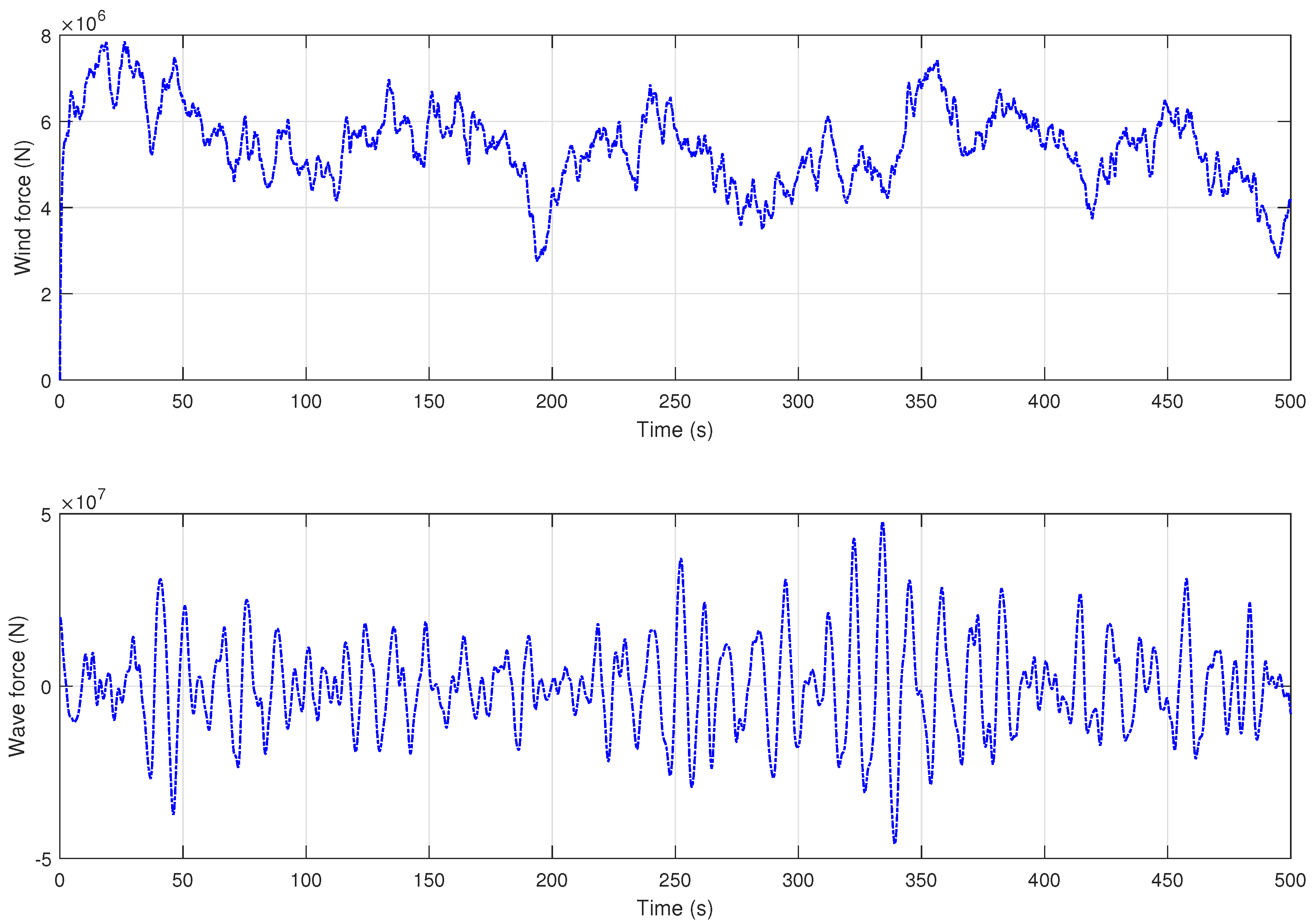

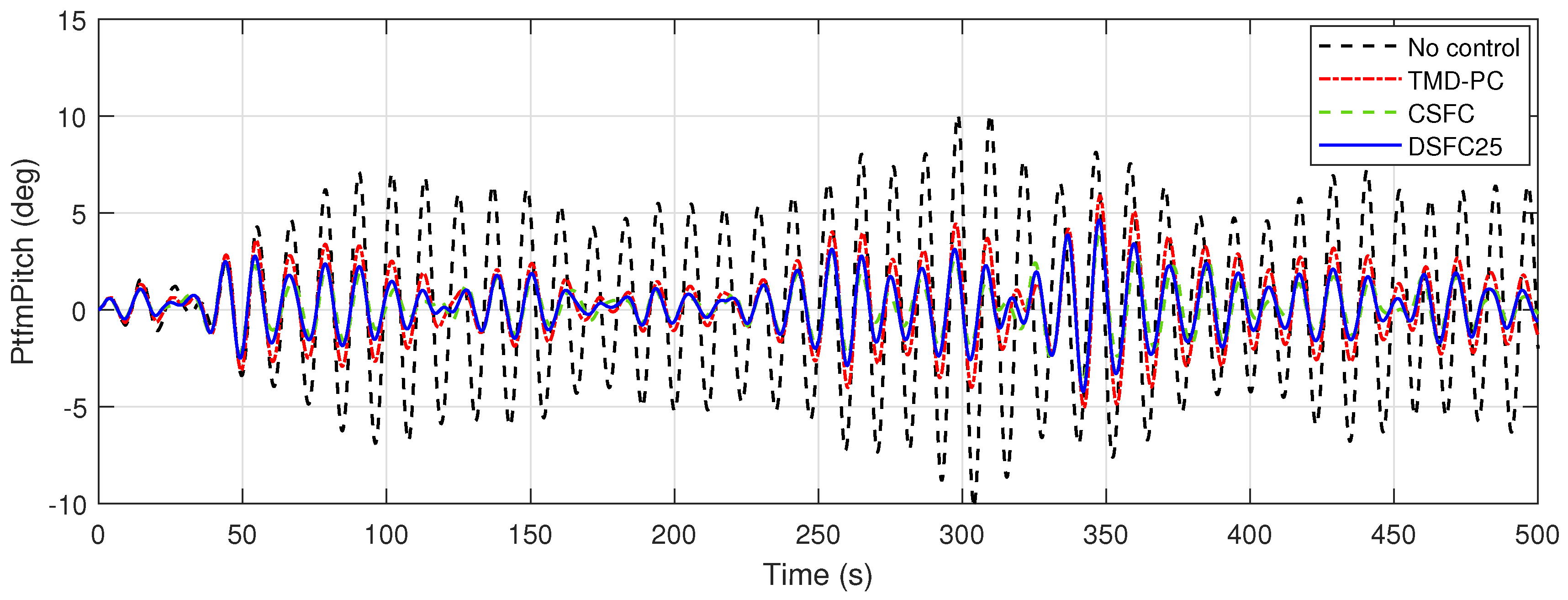
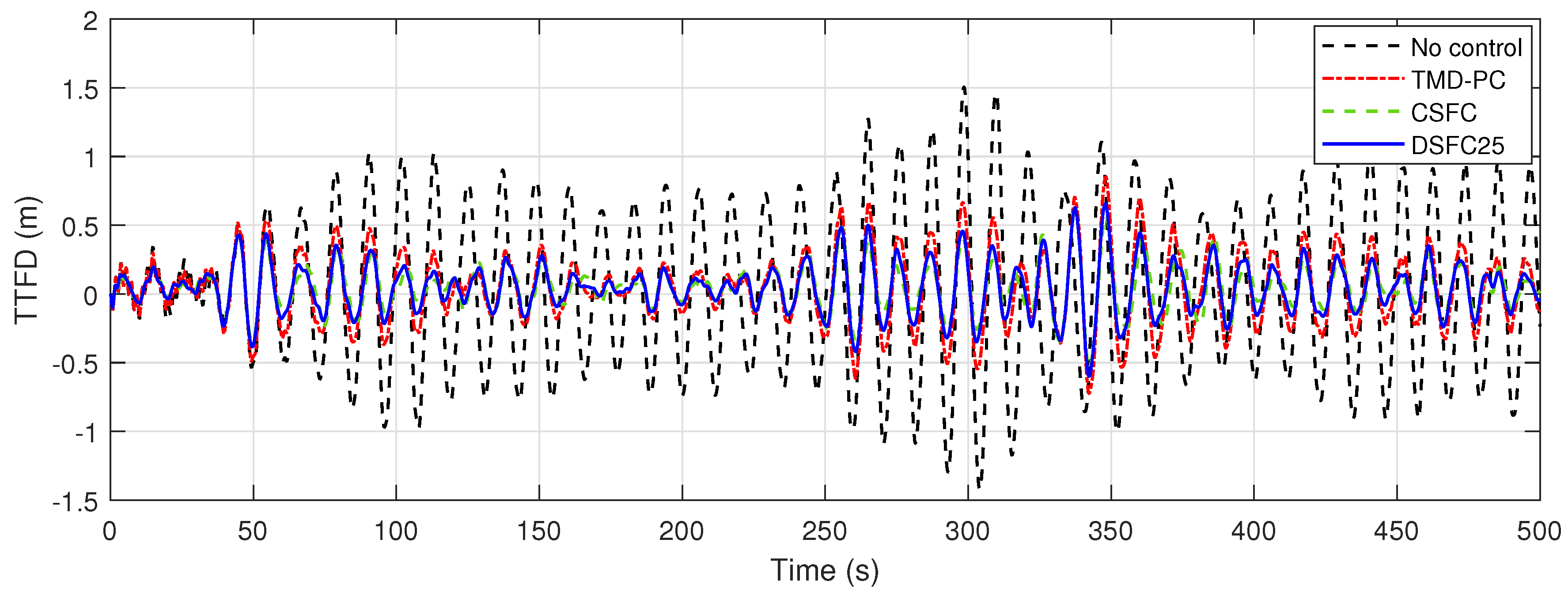

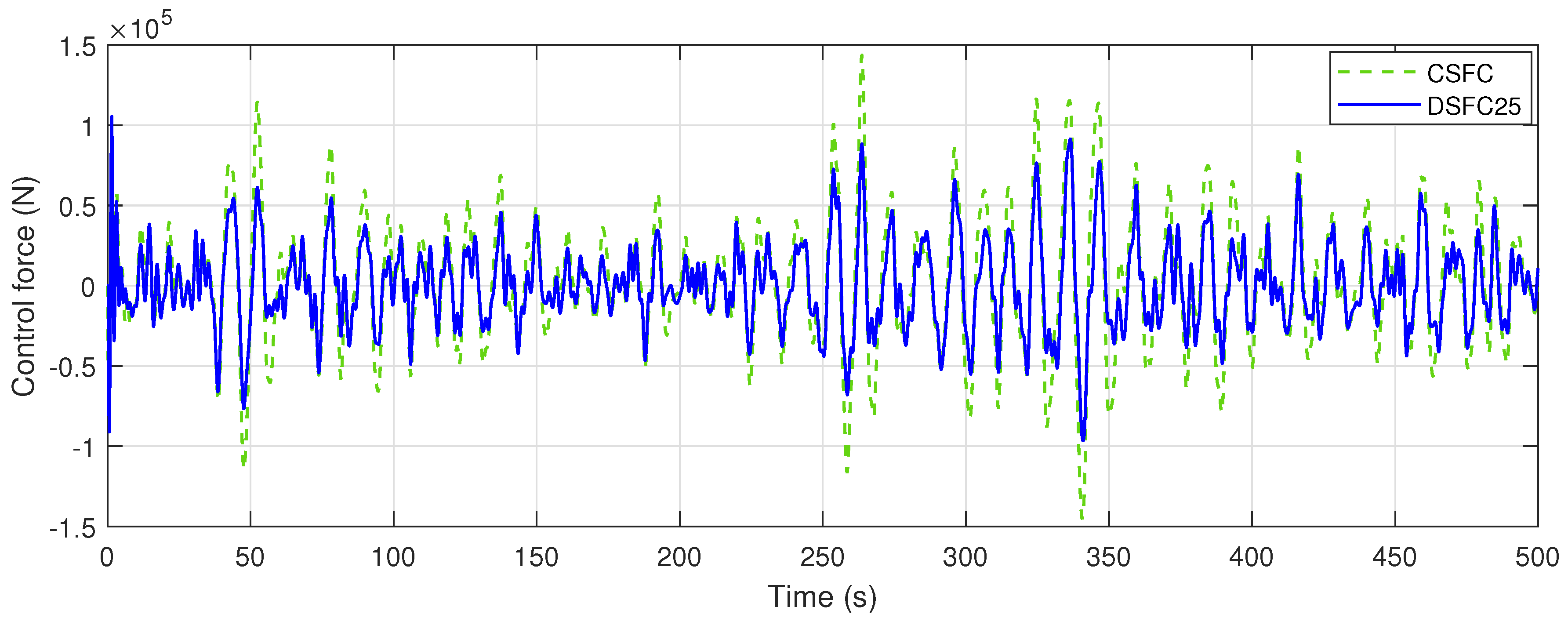
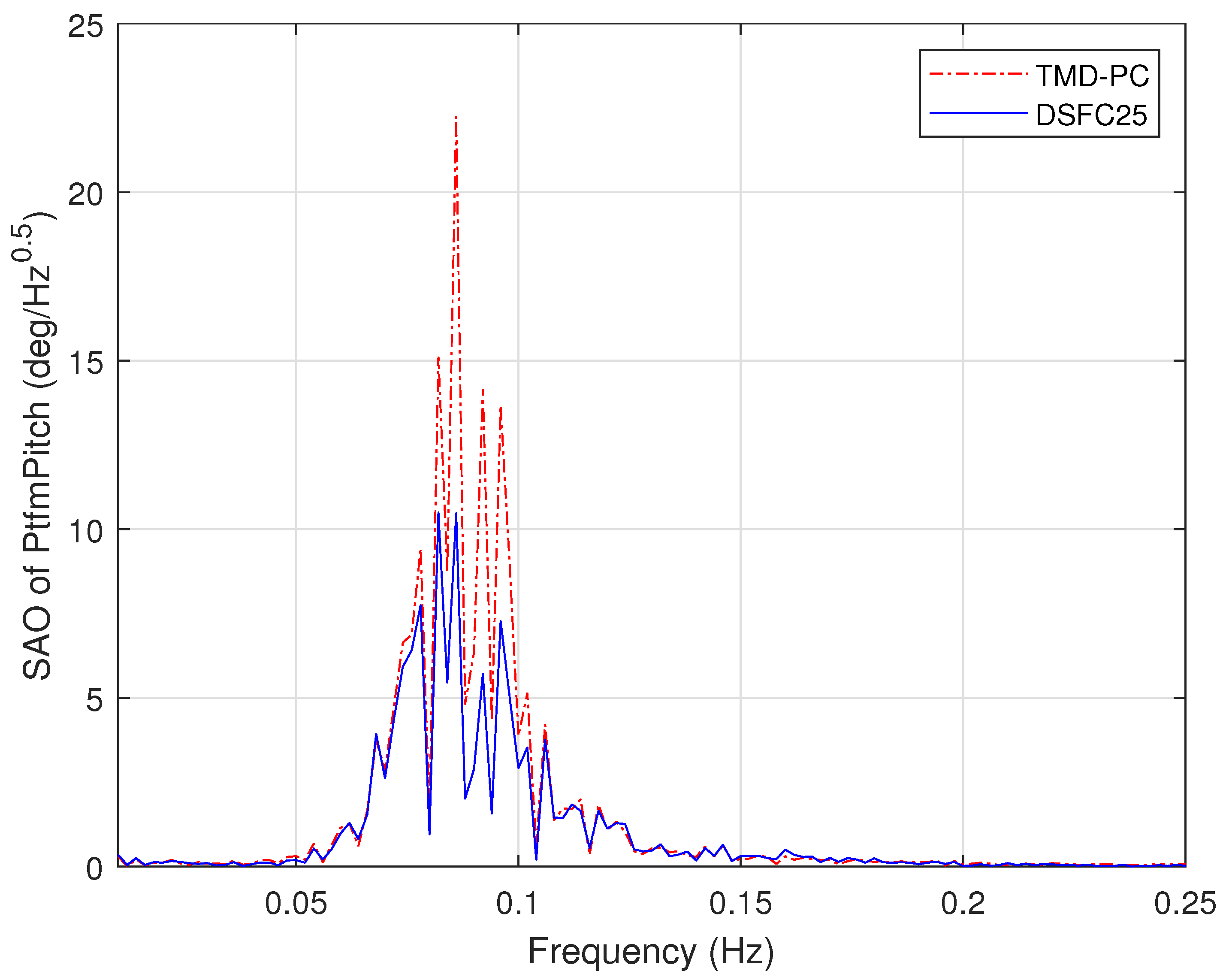
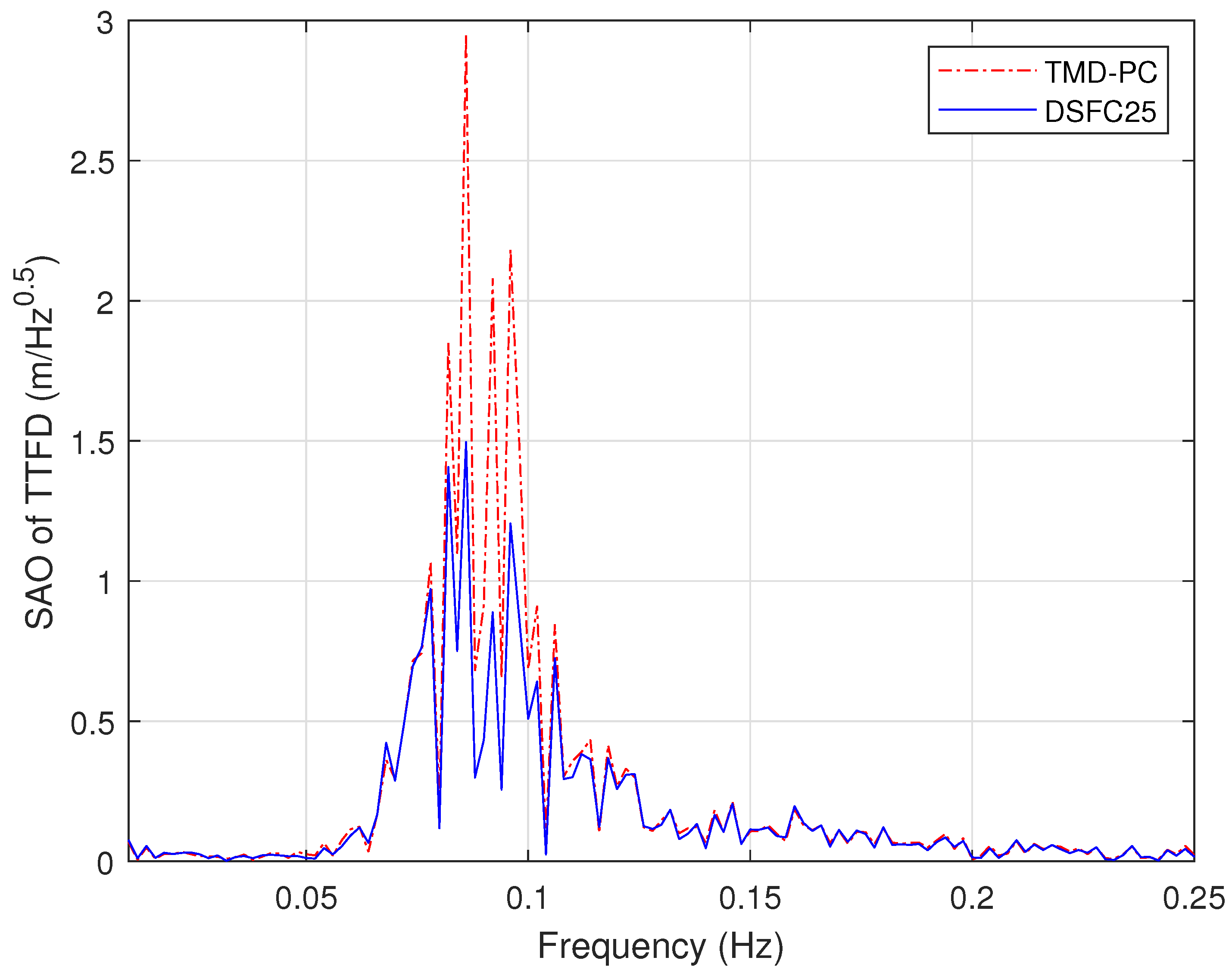
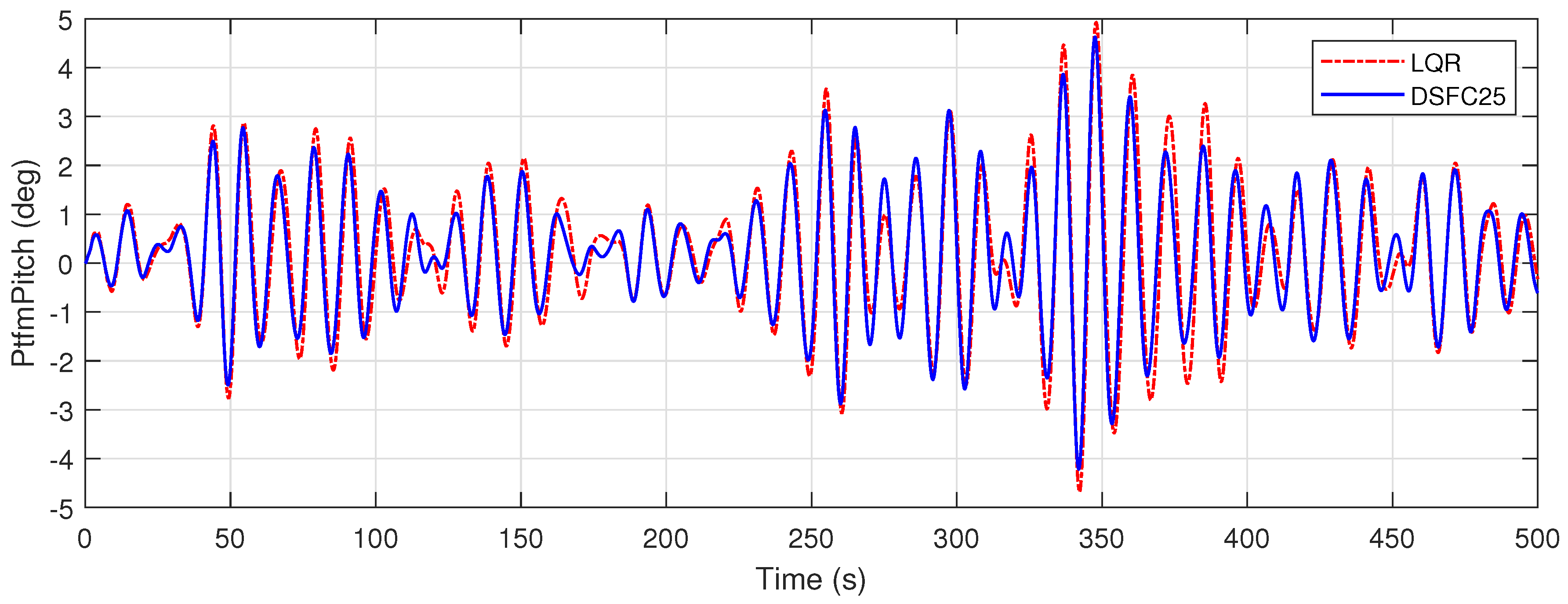
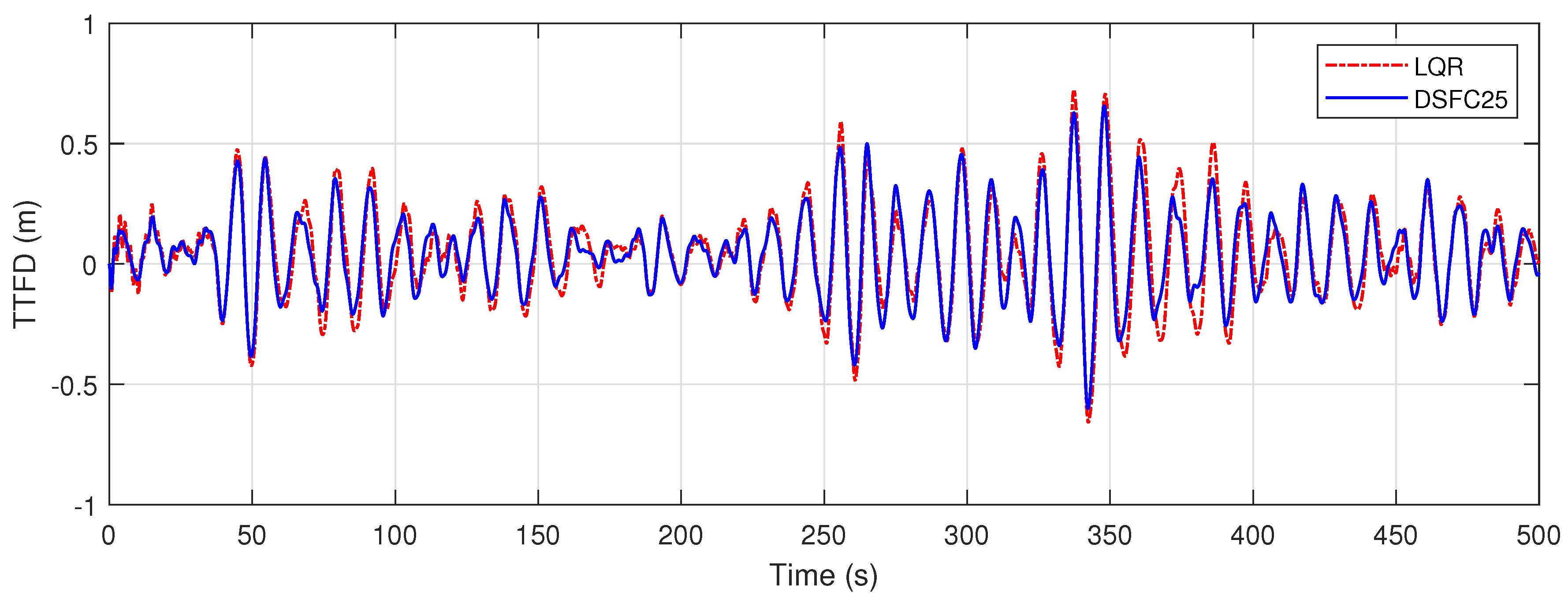
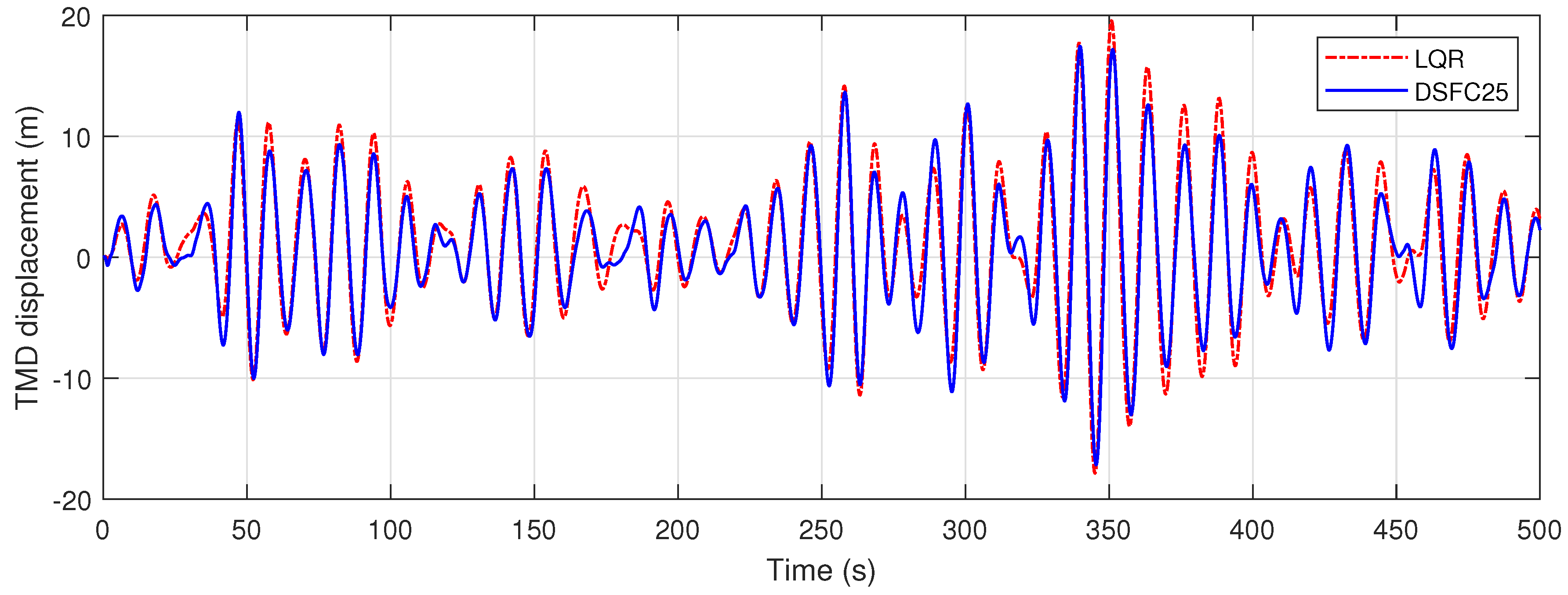
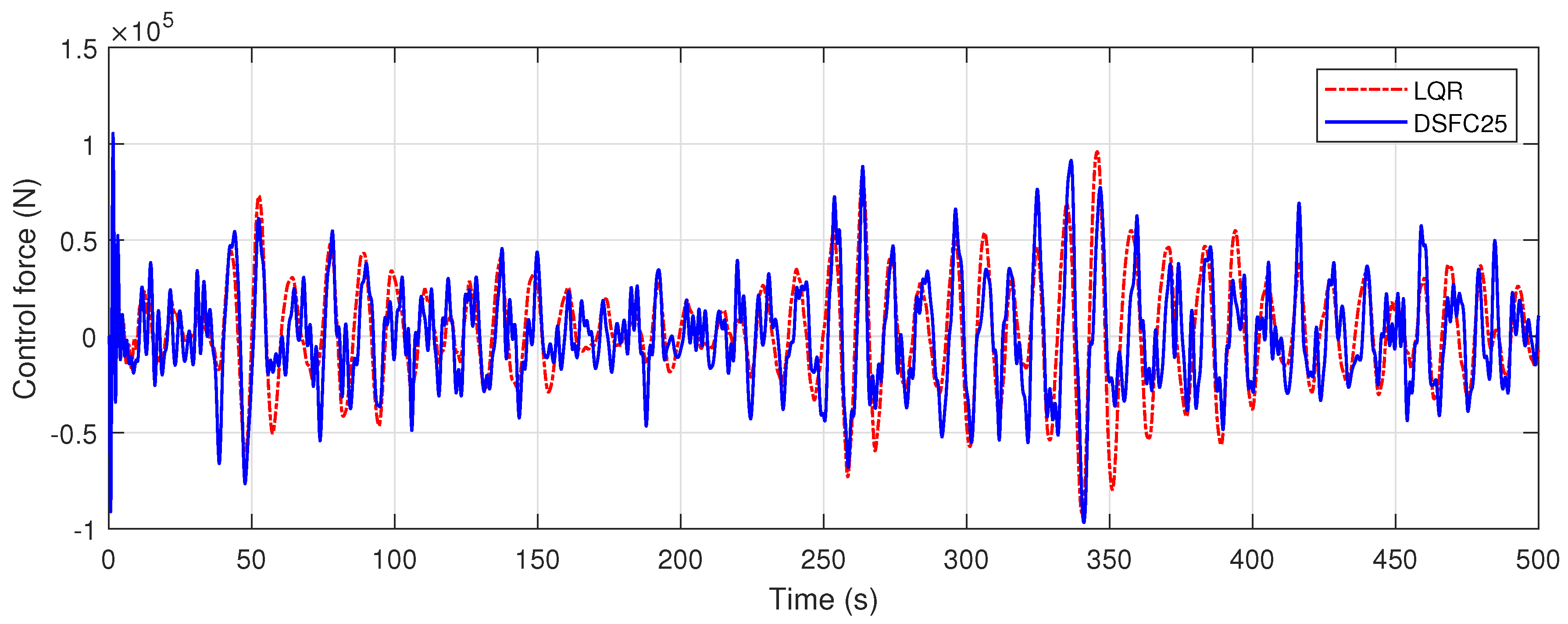
| Parameters | Values | Parameters | Values |
|---|---|---|---|
| 126 m | 0.28 m | ||
| 64.21 m | 90.6 m | ||
| 40 × 10 × 10 | 24 × 8 × 6 | ||
| 1.8735 × N m/rad | 1.3604 × N m/rad | ||
| 5.4151 × N m s/rad | 2.3087 × N m s/rad | ||
| 5274 N/m | 10,183 N/m | ||
| 2.0577 × kg | 3.1051× kg |
| Controllers | |||||||
|---|---|---|---|---|---|---|---|
| No control | 4.2518 | 0.5941 | – | 10.1134 | 1.5055 | – | – |
| TMD-PC | 1.8275 | 0.2564 | 4.2241 | 5.8882 | 0.8516 | 13.9194 | – |
| CSFC | 1.1117 | 0.1631 | 5.9557 | 3.8250 | 0.6155 | 21.1931 | 3.9723 |
| DSFC25 | 1.2881 | 0.1800 | 5.2710 | 4.6297 | 0.6565 | 17.4487 | 2.6508 |
| Controller | |||||||
|---|---|---|---|---|---|---|---|
| LQR | 1.4217 | 0.2023 | 5.6245 | 4.9293 | 0.7245 | 19.5667 | 2.7515 |
| DSFC25 | 1.2881 | 0.1800 | 5.2710 | 4.6297 | 0.6565 | 17.4487 | 2.6508 |
Disclaimer/Publisher’s Note: The statements, opinions and data contained in all publications are solely those of the individual author(s) and contributor(s) and not of MDPI and/or the editor(s). MDPI and/or the editor(s) disclaim responsibility for any injury to people or property resulting from any ideas, methods, instructions or products referred to in the content. |
© 2024 by the authors. Licensee MDPI, Basel, Switzerland. This article is an open access article distributed under the terms and conditions of the Creative Commons Attribution (CC BY) license (https://creativecommons.org/licenses/by/4.0/).
Share and Cite
Yan, S.; Wang, Y.; Pang, F.; Zhang, W.; Zhang, B.-L. Wind and Wave-Induced Vibration Reduction Control for Floating Offshore Wind Turbine Using Delayed Signals. J. Mar. Sci. Eng. 2024, 12, 1113. https://doi.org/10.3390/jmse12071113
Yan S, Wang Y, Pang F, Zhang W, Zhang B-L. Wind and Wave-Induced Vibration Reduction Control for Floating Offshore Wind Turbine Using Delayed Signals. Journal of Marine Science and Engineering. 2024; 12(7):1113. https://doi.org/10.3390/jmse12071113
Chicago/Turabian StyleYan, Shouxiang, Yilong Wang, Fengbin Pang, Wei Zhang, and Bao-Lin Zhang. 2024. "Wind and Wave-Induced Vibration Reduction Control for Floating Offshore Wind Turbine Using Delayed Signals" Journal of Marine Science and Engineering 12, no. 7: 1113. https://doi.org/10.3390/jmse12071113





